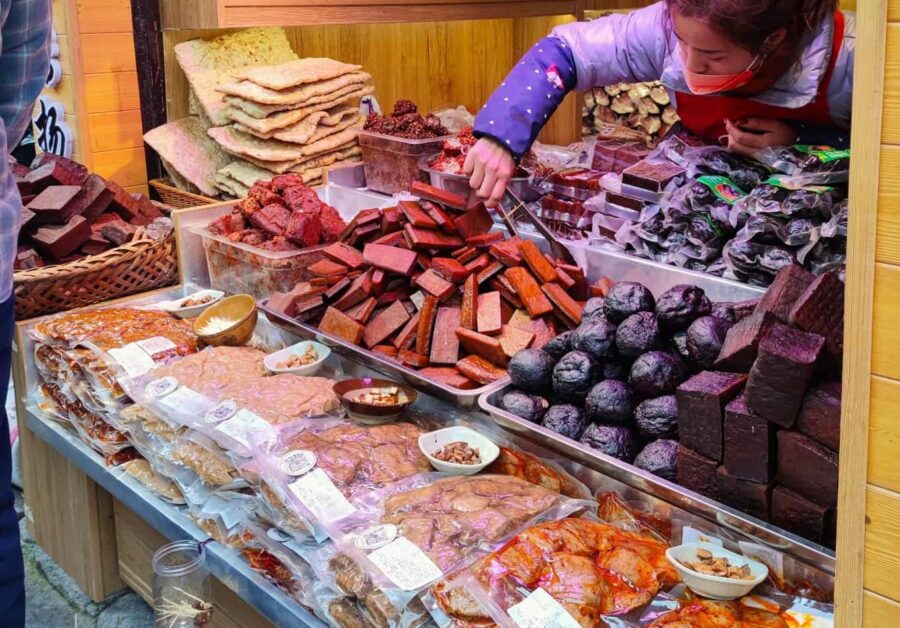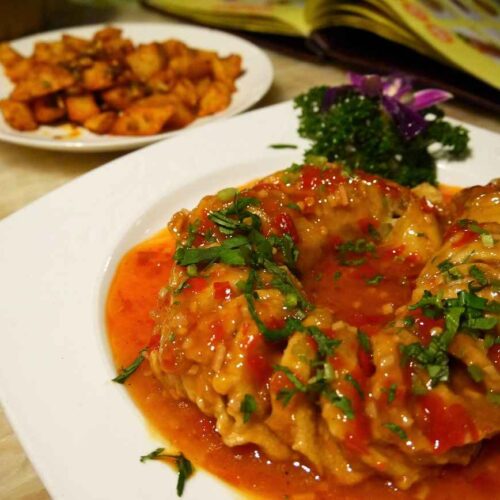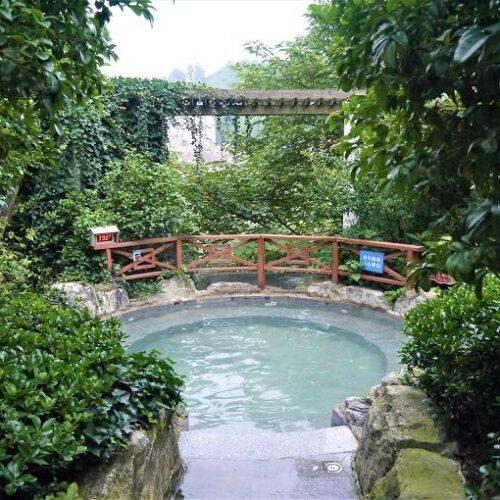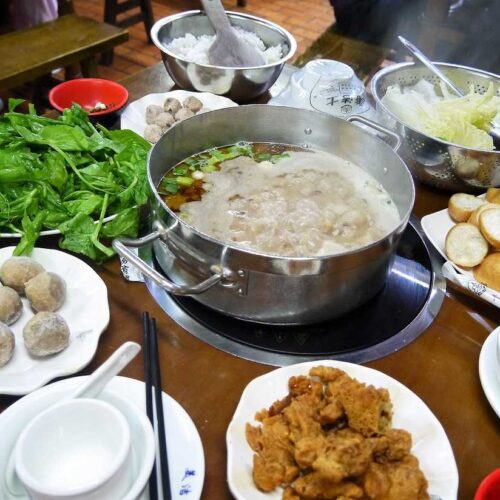Qingyan Old Town is 29 KM south of Guiyang, and makes for an excellent day trip. The fortress was originally built in the late 1300s, and has been expanded and rebuilt over time since then. It’s a popular destination for local tourists as well as foreign, so be prepared for crowds when you visit. It’s really a lovely place to go, though. Packed with temples and small museums, with streets lined with food and shops, it’s a lively and interesting stop for visitors to Guiyang. The old town isn’t particularly big, so it’s ideal for strolling around. Head out early in the day to get the most of your visit.
While Qingyan is full of small temples and museums, a major part of your visit will be spent at the shops lining the streets. From bowls full of local chili concoctions, to dried fruit, souvenirs and food, Qingyan is a feast for the eyes and stomach. Feel free to try bargaining a bit, but if you don’t like the price at one shop, you’re sure to find several more with the same offerings while you wander.
Qingyan has a few specialties that you’ll see all over. Pig trotters are available at every restaurant and sold at half the shops in town. Aside from trotters, you’ll find plenty of smoked pork. Keep an eye out for 腊肉 (là ròu), thick slabs of smoked pork with a stark white fat layer. It’s salty and smoky, and featured in many of the stir-fried dishes in the area. Alternatively, there are beautiful smoked sausages at the same shops, which are super juicy due to the generous marbling of fat throughout.
As you wander the town, it’s easy to sample and snack your way around. There are nutty sesame desserts and candied fruit skewers, the bright red juice of the Chinese bayberry (酸梅汤 suān méi tāng), and multiple sticky rice concoctions. You can find 稀饭(xī fàn), a bowl of warm, gooey rice flour with nuts, seeds and brown sugar. In the summer, go for 冰粉 (bīng fěn) instead. It’s similar flavors and ingredients, but it has a brown sugar and rosewater base with scoops of vegan jelly along with the nuts and seeds and is served iced.
Of course, there’s nowhere in Guizhou that you won’t see local chilis for sale, and Qingyan is no exception. The chilis pictured here are fried and seasoned, and you can pop them in your mouth and crunch away on them like potato chips. If you need some courage before you eat them, grab some 米酒 (mǐ jiǔ), the local rice wine. There are sweet and strong varieties, and shopkeepers will be happy to let you try all sorts before you buy.
Some are infused with honey, others with fruit, and still more are just different brewers’ takes on the basic wine. Mǐjiǔ is usually between 20-30% alcohol, so it’s much friendlier than the strong báijiǔ,the typical Chinese spirit (which is also sold and sampled here, so ask which one you’re about to sip). The flavor is a bit vinegary at first, but after a couple tastes, it’s sweet and goes down far too easily. It’s generally sold by the jin, a measure roughly equal to a pound, or 500g. The prices are absolutely open to bargaining. At this place, the (pre-bargaining) price was 60 per jin, and a bottle holds two jin. We paid a bit less than that for the first bottle, and then managed to get it down to 60 for the whole bottle when we came back for more. My personal favorite is 女儿红糯米酒, a fruity take on the wine.
The star of the show for me are the many varieties of tofu you can get in Qingyan. Here, you can see large white rectangles of stacked 泡豆腐 (pāo dòu fu) in the background, a tough, fried tofu that you’ll find in the local dish 鸡汁豆腐 (jī zhī dòu fu). It’s torn into chunks and sauteed with chicken broth to make a juicy, flavorful dish. Next to it, there are two tubs of 霉豆腐 (méi dòu fu), fermented cubes of tofu rolled in chili powder. It’s commonly used in dipping sauces for hotpot or dumplings. Next to that, there’s a heap of 香干 (xiāng gān), firm smoked tofu. Its neighbor, the black balls, is 血豆腐 (xuè dòu fu), or blood tofu. There’s a bit of pork blood and sometimes ground pork stirred in before the tofu is congealed. Then, it’s rolled into a ball and smoked. Next to that is another variety of firm, smoked tofu, and below, a row of snacking tofus. Each is seasoned with chili oil, and different spices. Luckily, most vendors have samples out so you can try before you buy!
Get There
You can get to Qingyan by bus or taxi. A taxi should take just under an hour and cost around 70 RMB from Guiyang’s downtown. If you’d rather take the bus, you can catch the 210 from Hebin Park (3 RMB, bring exact change). If you can’t spot it right away, just ask somebody for directions. (210 号公交车在哪里? — èr yī sān háo gōng jiāo chē zài nǎ lǐ? — Where is the 210 bus?)
The bus takes about an hour and arrives near the west entrance. Buses run from 7 AM to 9 PM. While the village is technically “open” all day, most of the temples, churches and touristy bits close around 5:30. Take the bus back to the city. Taxi drivers try to charge crazy amounts (200+ RMB!) to go back. If you can bargain with them, feel free, but it’s much less stressful to just hop on the bus.









